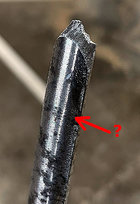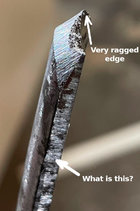If it is carbon steel it's probably in the 1075 to 1084 range. What I'm writing can be applied to most carbon steels if does happen to be something else. The first thing I see when
I look at the area where the gouge has broken is the very course grain structure of the steel. It's so course that I can only assume that whoever made it skipped the normalizing part
of the heat treating process. Normalizing is done to refine the grain structure of the steel, you do this up to three times prior to the heat/quench and temper part of the process.
The picture I included shows 1084 steel (the top two pieces) that has been normalized. The You can see that the grain structure is much more refined than what you see on your gouge,
it's still a bit too coarse for a great cutting tool though. The bottom piece is 5160, it's a different steel but the grain structure is ideal and how the two top pieces should look. If the
entire heat treat process goes correctly the steel will be hard, tough and flexible and the grain structure would look similar to the bottom piece.
It's also likely that the gouge was never tempered properly, after you quench the steel in oil or water it's extremely hard but also very brittle. Oil is usually used on carbon steels
with thin cross sections. Water quenching thinner cross sections can cause cracking in the steel. Carbon steel can shatter like glass if it's dropped after quenching. Tempering changes
the mechanical properties of the steel, the overall hardness of the steel decreases while it's toughness increases, it goes from a piece that can shatter like glass to being flexible.
The same process is used to make springs.
If the steel is heated too far above it's critical temperature prior to quenching the grain size can also rapidly increase. All those rough grinding marks on the side of the gouge create opportunities
for the steel to break if it's brittle from a poor heat treat. It's better to have all surfaces smooth on a carbon steel cutting tool, even if it's properly made. It's only flexible to a certain point, any
rough surfaces and gouges in the metal from coarse grinding are possible fracture points.
The pitting and discoloration (scale left from heat treating) of the gouge is similar to what you'd see on tools made in a blacksmith style forge. Normally enough steel is left to grind and polish out any and pitting.
It may be a home built tool or just very old. Carbon steels are great cutting tools if properly made, they hold a razor sharp edge and are reasonably tough. I still use them if I need a
custom cutting tool for a one off job. High speed steel, carbide and other tool steels have mostly replaced carbon steel cutting tools these days.
All that said your better off getting a new gouge. Unless you go through the normalization, heat, quench and temper process the gouge will break again. Even then your not guaranteed
a good result, the process varies slightly for each grade of steel. It's better to find a new tool than mess around with a mystery steel.
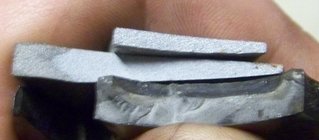
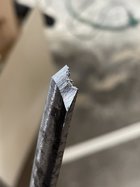 WWW
WWW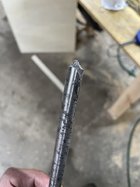 WWW
WWW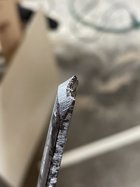 WWW
WWW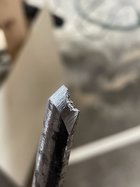
 WWW
WWW WWW
WWW WWW
WWW

